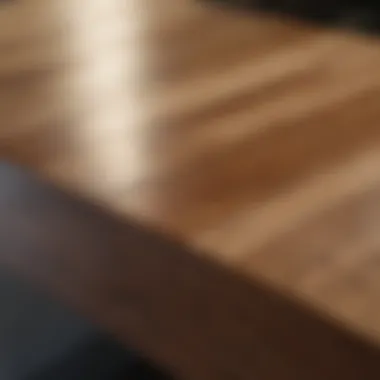Butcher Block Countertops: Stylish Addition to Laundry Rooms


Intro
When it comes to laundry rooms, the balance between style and utility can often feel like walking a tightrope. Enter butcher block countertops: a sublime blend of aesthetic charm and practicality. This material has moved far beyond the kitchen, finding its place in spaces often overlooked in terms of design.
Butcher block brings warmth and character, making a laundry room not just a utility space, but also a small haven where daily chores can become a touch more enjoyable. This piece will dive into the current trends surrounding these countertops, visual ideas for integrating them into your space, and the overarching benefits they offer.
Current Trends
Color Palettes
In the realm of laundry rooms, color choices are leaning towards serene and natural hues. Think soft grays, earthy browns, and creamy whites. These colors not only enhance the beauty of butcher block but also make the space feel airy and spacious. Popular variations include:
- Natural finishes that preserve wood's original look.
- Light stains that offer a brighter sensation without overshadowing the beauty of the wood.
- Contrasting colors for the cabinets or walls, like navy blue or forest green, can make the warmth of butcher block visually pop.
Popular Styles
While the overall style is more rustic and organic, contemporary designs are also making headway. Here are a few styles gaining traction:
- Farmhouse: Perfect for those who want a touch of cozy charm. Often paired with open shelving and vintage accents.
- Modern minimalist: Features clean lines, paired with sleek appliances and simple decor to create a functional yet stylish atmosphere.
- Industrial chic: Combines wood with metals and rough textures, adding an edgy contrast to the warm tones of butcher block.
Visual Ideas
Before-and-After Transformations
One of the most compelling aspects of incorporating butcher block in a laundry room is the dramatic change it can bring. Some transformations include:
- A dated, sterile laundry finish turned into a welcoming and functional space.
- Standard countertops swapped out for rich, textured butcher block that adds to usability while elevating style.
Gallery of Styled Spaces
Imagining your laundry room can be easier said than done. Visual aids help bridge the gap. Popular setups include:
- A spacious, light-filled room with large butcher block countertops accommodating laundry tasks and folding clothes.
- A compact area made more efficient with strategically placed butcher blocks that help in organizing and multitasking.
Incorporating butcher block countertops in your laundry room offers more than just a pretty face; it promises enhanced utility wrapped in a stylish package. As we move further, explore the practical elements as well as the care that comes with maintaining the beauty of this extraordinary material.
Preface to Butcher Block Countertops
When considering the perfect choice for countertops in a laundry room, butcher block offers a unique blend of form and function. In this section, we will delve into what butcher block countertops are, why they are relevant in contemporary design, and the relationship they cultivate between aesthetics and practicality.
Butcher block countertops are made primarily from hardwood, bonded together to create a surface that's not only beautiful but also robust. They bring a warm, inviting atmosphere to any space, making laundry chores feel a tad more pleasant. But it's not just about looks; these countertops are incredibly functional, serving well in a utility-focused area like the laundry room.
Definition and Composition
Butcher block countertops primarily consist of straight cuts of wood glued together to form a thick slab. Depending on the design, different wood species can be used, such as maple, walnut, or cherry. Each type imparts a unique character, color, and grain pattern, elevating the visual appeal of your laundry area.
Historical Context
The history of butcher blocks can be traced back to the early kitchens and butcher shops, where sturdy wood surfaces were essential for food preparation. Over time, this practical material transitioned into home design, embodying a rustic charm that appeals to homeowners today. Its journey from humble origins to a sought-after luxury reflects a growing appreciation for craftsmanship and natural materials in interior decor.
Why Choose Butcher Block for Laundry Rooms
When thinking about outfitting a laundry room, the choice of countertop can make all the difference. Butcher block countertops bring a blend of style and practicality that is hard to ignore. In a space that's often bustling with activity—whether it’s sorting, folding, or ironing—having a surface that works well and looks great is essential. Let’s dive deeper into why butcher block countertops deserve a spot in your laundry room.
Aesthetics of Natural Wood


Natural wood has a warmth and inviting quality that can transform even the most utilitarian spaces. Butcher block, with its rich textures and varied grains, serves as an attractive focal point in any laundry room. It can soften the hard lines created by appliances and cabinetry. Plus, each piece is unique; the knots and patterns in the wood give it character that can’t be replicated with synthetic materials.
Imagine walking into a laundry room that feels less like a chore zone and more like a cozy nook—a place infused with the rustic charm of wood that complements everything from farmhouse to modern aesthetics. By choosing butcher block, you're marrying functionality with beauty.
Functional Benefits
Durability
Durability is one of the standout characteristics of butcher block countertops. Unlike some surfaces that are prone to chipping, cracking, or staining, butcher block can withstand the daily wear and tear that comes with laundry duties.
- Key Characteristic: The ability to endure heavy use without showing significant signs of aging.
- Why It's Beneficial: Being resilient against impacts and scratches means that your countertop can look new much longer. It's like the trusty friend who shows up every time you need help.
- Unique Feature: Even if it gets a few nicks from sharp objects, these imperfections can often be sanded out, restoring the surface to its former glory.
Surface Versatility
In the context of a laundry room, surface versatility can be a game changer. Butcher block countertops can serve multiple functions—from a workspace to a sorting station and even a folding area.
- Key Characteristic: This material can handle hot items temporarily, making it a practical option for laundry tasks, where you might place warm laundry straight from the dryer.
- Why It's Beneficial: The adaptability means that whether you’re pressing clothes or stacking linens, butcher block rises to the occasion.
- Unique Feature: Furthermore, it allows you to mix and match with various kitchenware while keeping a cohesive look throughout the home.
Ease of Maintenance
Butcher block countertops are often praised for their simple maintenance requirements, especially in a laundry room setting.
- Key Characteristic: They can typically be cleaned with a mild soap and warm water—no need for harsh chemicals.
- Why It's Beneficial: Given the frequency and nature of activity in a laundry room, the straightforward upkeep can save valuable time, allowing you to focus on what matters.
- Unique Feature: Routine oiling can enhance their lifespan and beauty, acting as a protective barrier while adding moisture back into the wood.
Sustainability Aspects
Choosing butcher block does not only favor aesthetic and practical use; it also supports sustainable practices. This material is often sourced from responsibly managed forests, ensuring that new growth matches what is harvested. In a world where environmental awareness is critical, opting for wooden surfaces can contribute towards greener choices in home renovations.
"Using butcher block countertops in your laundry room isn't just about looking good; it's a step toward sustainable living."
Design Considerations for Integration
When it comes to selecting butcher block countertops for laundry rooms, one cannot underestimate the significance of design integration. It's not just about functionality; how the countertops meld with the existing decor can fundamentally affect the overall vibe of the space. A laundry room that feels cohesive not only looks appealing but can also make the mundane chore of doing laundry more enjoyable.
Complementing Existing Decor
Before diving into materials and finishes, it’s crucial to assess the current aesthetic of the laundry room. Are the walls painted a cool blue or a warm beige? Does the room boast modern stainless steel appliances, or does it lean more towards a rustic farmhouse look? The key here is to highlight the strengths of the existing decor while enhancing it with the natural beauty of butcher block.
For instance, if your laundry room features white cabinetry, a honey-toned butcher block can offer a delightful contrast, creating a welcoming and warm touch. On the other hand, if you're looking to keep things sleek and modern, opting for a dark-stained wood might align better with your vision, adding an element of sophistication without being overpowering.
Some practical tips include:
- Opt for butcher block in tones that mirror or complement other wooden elements in the house.
- If the laundry room is part of an open layout, try to ensure that the countertops tie in with adjoining spaces.
- Think about the style of hardware and fixtures when selecting the grain or stain of the wood for a consistent look.
Choosing Color and Finish
Selecting the right color and finish can be a fine balancing act. Butcher block can come in various hues, from light maple to dark walnut. The finish also plays a pivotal role in both appearance and maintenance. A matte finish typically offers a more rustic and understated vibe, while a glossy finish can yield a more sophisticated look but may be harder to maintain.
In terms of practicality, keep in mind how the colors and finishes will wear over time. Lighter woods might show stains more than darker ones, so it might be wise to consider the laundry room's primary function. For instance, if children or pets frequent this space, opting for a darker shade could disguise any accidents better.
Some factors to consider:


- Durability: Some finishes protect better against moisture and stains.
- Design Intention: Consider the emotional response the chosen color evokes. Natural tones often feel more calming and inviting.
- Ownership of Material: Think about how you want your wood to age. Some colors will deepen over time, while others may lose luster.
Countertop Thickness and Style
The thickness and style of butcher block countertops can greatly influence the overall design narrative of your laundry room. Thicker countertops often evoke a more robust and traditional feel, which can be great if you're going for a rustic look. Thinner, sleeker designs can present a more modern appearance, fitting seamlessly in contemporary settings.
While selecting thickness, consider the functional needs:
- Thickness between 1.5 to 2 inches is standard and can generally accommodate heavy loads without compromising integrity.
- A thicker countertop can also allow for creative features such as built-in cutting boards, which can be practical in a multitasking laundry space.
Furthermore, the style is equally important. Consider whether rounded edges or squared-off designs better fit your vision. Rounded edges can soften the look, whereas clean lines offer a more modern aesthetic.
In summary, taking the time to carefully consider how butcher block countertops will integrate into your laundry room is critical. With the right decisions, you can create a space that is not only functional but is also a reflection of your personal style.
"The design of a space is a reflection of its owner's personality. Investing time in design choices lays the groundwork for a space that feels just right."
Ultimately, your laundry room can be as stylish as any other room in your home, showcasing not only the beauty of wood but also your skill in creating a harmonious living space.
Maintenance and Care of Butcher Block Countertops
Keeping butcher block countertops in top shape is not just a matter of aesthetics; it also speaks to their longevity and functionality. A well-maintained countertop can endure the rigors of daily use while maintaining its natural beauty. It's not unlike keeping a classic car running smoothly; with the right care, your countertops can remain a focal point in your laundry room for years to come.
Routine Cleaning Techniques
When it comes to everyday upkeep, routine cleaning is essential. A gentle approach works best for butcher block. Here’s what you can do:
- Wipe Down Daily: After each use, give the countertop a quick wipe with a damp cloth. This removes any dust or residues without the harshness of commercial cleaners.
- Use Mild Soap: If you need more than just a wipe, a mixture of warm water and mild dish soap can do wonders. Apply it using a soft sponge and rinse with clean water, ensuring there are no soap residues left.
- Avoid Excessive Water: Wood doesn’t mix well with water, so avoid soaking your countertops. Remember, it’s not a water park!
By keeping up with this simple routine, you can prevent grime build-up, making the deeper cleaning tasks much easier.
Dealing with Stains and Damage
Stains are part and parcel of any countertop. The key is to tackle them as soon as you notice them, rather than letting them fester like a bad mood.
- Quick Response: For minor spills, especially from liquids like wine or juice, blot immediately. Rubbing may spread the issue.
- Natural Solutions: For stubborn stains, a paste made from baking soda and water can be an effective scrub. Apply it, let it sit for a few minutes, and then scrub gently with a soft cloth.
- Handling Scratches: Deep scratches can occur, but don’t fret! Use a fine-grit sandpaper to gently sand the damaged area with the grain of the wood, then clean and re-oil.
Maintaining the beauty of your butcher block requires vigilance. Instead of letting unsightly stains linger, dealing with them promptly will keep your countertops looking fresh.
Periodic Oiling and Refinishing
Oiling isn’t just an add-on; it’s a crucial part of keeping butcher block countertops happy and healthy. Here’s why and how to do it effectively:
- Why Oil Matters: Regular oiling helps to maintain moisture levels, preventing the wood from cracking or warping. Think of it as a refreshing drink for your countertops.
- Frequency: Aim to oil at least once a month. If you notice your countertop looking dry or dull, it’s a sure sign that it’s time for a top-up.
- How to Oil: Use food-grade mineral oil or a specialized countertop conditioner. Apply with a clean cloth in the direction of the grain, ensuring even coverage. Let it sit for at least 15-20 minutes, then buff off any excess.
"Regular care can make a world of difference in the lifespan of your butcher block; think of it as an investment in your home."
By integrating these care techniques into your routine, you’ll not only preserve the beauty of your butcher block countertops but also enhance the entire laundry room’s atmosphere, making it a place you enjoy spending time in.
Potential Drawbacks to Consider
When embracing the charm of butcher block countertops in laundry rooms, it's essential to weigh some potential drawbacks. While the aesthetics and functionality are often lauded, being aware of the downsides can prepare you for practical challenges. If you aim to understand the overall impact on your home improvement plans, let’s dive into two specific concerns: sensitivity to moisture and the risk of scratching and gouging. This knowledge helps you plan effectively and ensure that the elegance of wood in your utility space doesn’t come at the cost of functionality or longevity.


Sensitivity to Moisture
One notable drawback to butcher block countertops is their sensitivity to moisture. Unlike countertops made from materials like quartz or ceramic, wood is inherently porous. This porous nature means that excessive exposure to water can lead to swelling, warping, or even the growth of mold or mildew. In a laundry room, where water spills or splashes might be a daily occurrence, this sensitivity can pose a practical challenge.
To mitigate these risks, it’s crucial to maintain an effective cleaning routine. Instead of soaking the surface, figure out cleaning methods that employ damp cloths or mops with minimal water. Additionally, applying a protective sealant can help safeguard against moisture, but keep in mind that this protection requires periodic reapplication to remain effective. Keeping the humidity levels in check can also be beneficial. Investing in a good dehumidifier or ensuring proper ventilation could be prudent steps to consider.
Possible Scratching and Gouging
Another issue to keep on your radar is the susceptibility of butcher block surfaces to scratching and gouging. While the natural beauty of wood is enticing, it can also be delicate. Heavy objects dropped or rough usage may cause unsightly marks on the surface, turning your beautifully crafted countertop into a distressed-looking one sooner than expected.
To avoid this, it may help to adopt some precautionary practices. Utilizing cutting boards and avoiding placing heavy items directly onto the countertop can mitigate scratches. Moreover, using trivets or coasters can prevent hot pans or liquids from sharing direct contact with the wood. If gouging does occur, don’t fret entirely; many scratches can be sanded out easily with a bit of elbow grease. Just remember that this too requires regular upkeep.
"By understanding and addressing these potential drawbacks, you can enjoy the beauty and functionality of butcher block countertops without compromise."
Personalization and DIY Options
Integrating butcher block countertops into laundry rooms offers a unique chance to create a space that reflects personal style and practical needs. Personalization and DIY opportunities enable homeowners to shape their countertops according to their specific requirements and taste, turning a utility area into a more enjoyable environment. These elements also give a sense of ownership over a space that is often ignored in home decor discussions.
Customization Techniques
When it comes to customization techniques for butcher block countertops, the options are quite expansive. Homeowners can choose from various wood types like maple, oak, or cherry, each offering distinct aesthetics and durability.
- Wood Type Selection: The choice of wood dramatically impacts the look of the entire space. Maple, with its light, airy appearance, can make a laundry room feel more spacious, while darker woods like walnut can add warmth.
- Stain and Finish: Stains allow you to alter the color of the wood while preserving its natural grain. A clear finish will enhance the natural wood tone, while colored stains can match existing decor.
- Edge Treatments: The edges of the butcher block can be customized too. Whether you prefer a straight edge for a modern look or a more ornate profile, this detail can dramatically change the countertop's appearance.
- Inlays and Patterns: For more adventurous souls, consider inlays or intricate patterns. Adding a contrasting wood strip or creating a patterned layout can transform the countertop into a work of art.
"A kitchen isn't just a place for food; it should also be a reflection of the homeowner's personality."
DIY Installation Guidelines
Choosing to tackle the installation of butcher block countertops on your own can be both rewarding and cost-effective. However, there are several considerations to keep in mind to ensure a successful outcome.
- Measurement Precision: Start by precisely measuring the space where the countertop will sit. Take multiple measurements to avoid surprises, as even a small error can affect the fit.
- Tools Needed: Gather essential tools before starting the installation. Basic tools you’ll need include a circular saw, drill, sandpaper, and clamps. Have these on hand and ready to go.
- Cutting the Countertop: Use a circular saw for straight cuts. For corners, measure accurately and make relief cuts. Then sand the edges afterward to eliminate splinters.
- Securing the Countertop: Once cut, position the countertop in place. Use wood glue along the support beams and fasten with screws for a sturdy installation. Make sure the surface is level before securing.
- Finishing Touches: After installation, apply the chosen finish. If you opted for oil, allow the countertop to absorb it over a day or two, then buff it for a smooth touch.
The journey of personalizing and installing butcher block countertops can seem daunting at first, but it provides not only a functional outcome but also a deeply satisfying experience in turning a laundry room into a tailored space.
Closure: The Case for Butcher Block in the Laundry Room
When considering the overall functionality and visual harmony of a laundry room, butcher block countertops emerge as a compelling option. They offer more than just a surface; they serve as a testament to the marriage of practicality and aesthetics. By encapsulating the essence of utility and style, butcher block countertops create a focal point, transforming a often neglected space into an inviting area that enhances the daily grind of chores.
Summarizing the Benefits
Butcher block countertops bring with them a myriad of benefits that deserve a closer look. First off, their natural beauty grants an organic feel to laundry rooms, making them visually appealing. Compared to sterile materials, wood adds warmth and character, creating an atmosphere where mundane tasks seem less of a chore.
In terms of functionality, they provide robustness and durability. With the right care, butcher block can resist wear and tear from daily use, making it an investment in both aesthetics and practicality. Additionally, they boast great surface versatility. Laundry tasks often call for different needs—for folding, stacking, or sorting clothes. These countertops can handle it all without faltering.
Here are a few other points to consider:
- Natural wood can withstand a surprising amount of heat, making it resistant to scorching from hot containers.
- The ability to easily customize with oils or finishes allows homeowners to let their creativity shine through.
- With proper maintenance, butcher block can be exceptionally long-lasting and serves as a sustainable choice compared to synthetic materials.
Final Thoughts on Design Integration
Designing a laundry room with butcher block countertops is not just about practicality; it's about creating a cohesive space that aligns with your home's overall aesthetic. While blending with other elements in the room may seem a bit tricky, it can actually open up a world of opportunities. One approach is to select a finish that complements cabinetry or flooring.
For instance, a light-colored finish can elevate a room lit with natural light, while darker tones can add drama and depth to a more muted area. Utilizing accents like colorful baskets or cheerful wall art can beautifully contrast the rich hues of the wood, too.
Another tip is to think about the layout. If you have a small laundry room, a butcher block countertop can create an illusion of spaciousness due to its smooth lines and less cluttered appearance. In contrast, a larger space can accommodate a chunky, thick countertop that brings a sense of solidity.
By integrating butcher block countertops into your laundry room thoughtfully, you create a functional space that reflects your personal style and enhances the enjoyment of a once-ordinarry chore.
In summary, the incorporation of butcher block countertops not only provides a practical solution for a working environment but also adds a timeless appeal that can evolve with changing tastes and laundromat needs. As you weigh your options, consider how these surfaces can redefine not just your laundry experience, but also the entire look of the room.



